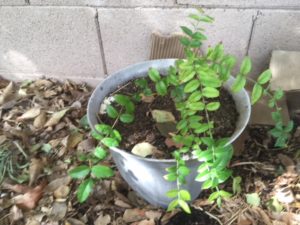Should I Grow Fruit Trees from Seed

When growing fruit trees, it generally isn’t recommended to grow from seed. Grafting, air layering, and rooting cuttings are typically the recommended ways to propagate fruit trees to ensure that you get quality fruit. Since a lot of seedlings don’t always replicate the parent tree, it can become a bit of a crap shoot to grow fruit trees from seed.
Should I try growing a fruit tree from seed? I’d say give it a shot. As long as you aren’t solely relying on seedling fruit trees for your backyard orchard, it can be fun to experiment. You may even discover a great new variety.
Things to Consider when Growing Fruit Trees from Seed
There are different factors to think about when deciding to grow a fruit tree from seed.
Some of which turns gardeners away from even trying to grow a fruit tree from seed.
Let’s take a look at a few of these factors.
Germination
It can sometimes be a challenge to germinate seeds or if you buy seeds from someone that isn’t reputable.
I’ve had plenty of seeds that just weren’t viable and they never germinated. There are different methods of germinating seeds, which can also make it challenging.
Wrapping the seed in a damp paper towel, placing it in a Ziploc bag, and storing it in a warm dark place is a fairly effective method.
Sometimes mold can be an issue doing it this way. Sometimes you can just place the seed directly in the ground or a cup with soil-less potting soil.
I’ve had success with both of these methods. It can be effective to scarify a seed (scraping some off the hard shell) to speed up germination.
Takes Longer
One of the things that deter a lot of gardeners is the amount of time it takes to get fruit grown from seed.
When you buy a typical grafted 3-5 gallon fruit tree it is already 2-3 years further along than a seedling starting out.
I’ve seen some fruit trees like Lychee or Jaboticaba that can take up to 10 years before they produce from seed.
Gardeners tend to be some fairly patient people or develop patience as they get more involved in gardening, but it still can be too long for some to wait.
Variable
When you purchase a grafted tree, it is an actual branch taken from the tree you desire, then attached to a rootstock made to thrive in your soil.
So, this method guarantees that you will have a replica of the desirable fruit. Growing from seed isn’t this way.
Sometimes seedlings can produce fruit that isn’t even edible, while others can produce a fruit that exceeds the quality of the parent tree.
Some varieties are more likely to produce a near replica from the parent tree, while other fruit tree varieties are more variable when attempting to grow from seed.
Reasons Why I Grow Fruit Trees from Seed

Again, I’m not writing this post to say grow everything from seed, but it’s fun to try a few seedlings.
I’m still a big believer in traditional propagation methods to get the tried and true varieties we love.
I currently have around 7 or 8 seedling grown trees in my yard.
Experimentation
I think most gardeners like to experiment with different things. A lot of gardening can be trial and error to find what works for you.
It always amazes me how some gardeners swear by certain methods or products, whereas others have success in totally different ways.
There are certain methods that work, but so much of gardening is also an art form. Even if something didn’t work for someone else, it may work for you, which makes experimenting so much fun.
Experimenting can help keep the gardening experience challenging and fresh.
Cost Effective
Some seeds can actually be quite expensive, but overall paying for some seeds is generally a lot cheaper than buying a tree.
The cost was the biggest factor for me when deciding to grow some fruit trees from seed.
I’d ask myself, Is it worth it to pay $75 bucks for a tree that is marginal for my climate and has a low chance of producing fruit or $10 for some seeds.
Marginal Climates
I live in zone 9B which means we get some occasional light frosts or temps below 30 degrees Fahrenheit.
With that being said, many tropical types of fruit trees don’t like any cold temps, let alone below freezing temps.
So, I’m in one of those fringe climates of growing subtropical and tropical fruit trees.
I also live in a very dry climate, which can cause some challenges for those same types of fruit trees that are traditionally grown in climates with high humidity.
Handle the Elements
I’ve found that seedling grown trees tend to handle the elements a little bit better.
I’m not saying that a seedling grown Mango tree can all of the sudden handle snow, but it does seem that seedlings can take a little more cold and our extreme heat over a grafted tree.
It may just be that they grew up in our elements or just being on their own root systems helps.
Fruit Trees that Grow Best from Seed

A lot of tropical fruit trees really grow quite well from seed and produce quality fruit from seeds.
In fact, several different tropical fruit trees are primarily grown from seed.
Here are some of the fruit trees that I’m trying from seed in a hot, dry climate, that you may want to consider.
Papaya
Papaya is a great tree to grow from seed. This is the go-to method of propagating papaya and it is basically guaranteed to get good quality papayas from a seedling tree.
You can scoop out the seeds of a store-bought Papaya and give it a shot.
Some varieties aren’t self-pollinating and require a male and female tree for cross-pollination so you may need multiple trees. Here is my post on growing Papaya.
Sugar Apple
Many of the fruit trees in the Annona family tend to produce good quality fruit from seed and it is a common propagation method.
Atemoya is a hybrid of Sugar Apple and Cherimoya, so it is mainly grafted, but I’m also experimenting with seedling grown Atemoya.
I also am growing a Soursop tree from seed, which is one of the most tropical of the Annonas.
Annonas grow pretty well in our hot, dry climate, but I’ve seen very few fruiting in our area, due to the lack of humidity, which is why I’m growing from seed.
Mango
I have several grafted trees, but one that I’m growing from seed. Many great varieties of mango have come from seed grown trees.
Mango seeds are either Monoembryonic or Polyembryonic. Monoembryonic seeds do not take on the characteristics of the parent tree, so you may or may not get quality fruit.
Polyembryonic seeds produce several clones of the parent tree, so it’s pretty likely you will get a tree similar to the parent. Polyembryonic Mangos are generally the Asian type mango varieties.
Moringa
This tree is really easy to grow from seed in hot climates. The entire tree is pretty much edible and has many nutritional benefits. It also tends to grow in poor soils and is a very rapid growing tree.
All of the fruit trees I’m growing from seed- Atemoya, Sugar Apple, Canistel, Papaya, Soursop, Red Hybrid Jaboticaba, Mango
Conclusion
Growing fruit trees from seed is another way to keep the gardening fun. If you have space, patience, and gardening skill it’s worth trying at least once.
Who knows, maybe you’ll discover the next amazing fruit variety.
Please comment below on anything you enjoyed from this post or your experience with growing fruit trees from seed.

So living in Michigan, can I grow a miniature mango in a pot, eventually a very large pot. And bring it in the house in the winter, and put it outside in the summer? I am doing that with a lemon seed plant, knowing it can grow into any citrus plant. Hopefully it will work.
Yes, you would need to make sure it gets enough light and stays warm in the winter. A Pickering Mango is a really good dwarf variety for a container. Getting it to fruit in Michigan would be the challenge. They tend to flower in Jan-Mar which is still really cold there.
I was given a small mango tree in a pot, I transferred to the ground
And it’s doing ok it seems to be sensitive I’ve noticed, it gets green then yellow leaves, then I have seen some brown spots or burns in in Ontario CA so it’s hot here, last summer my leaves just dried up, so I put an umbrella then it survived. I’ve had imyvtree for 2 years now, I don’t see any signs of fruit, when can I expect a sign of fruit? What fertilizer would you suggest?
Thank you
Leticia
If you shade your Mango tree, I’d recommend using a shade cloth so you’re still allowing it some sunlight. Here in the desert 50% shade cloth tends to work well. I have a seedling tree that is 3 years old and still hasn’t flowered. It usually takes 4-5 years before a seedling will start flowering. I use things like fish emulsion, liquid seaweed, Chelated Iron, rabbit manure, and Manganase Sulfate as fertilizer. We also have high PH here in Arizona, so I apply soil sulfur a few times a year, good luck.